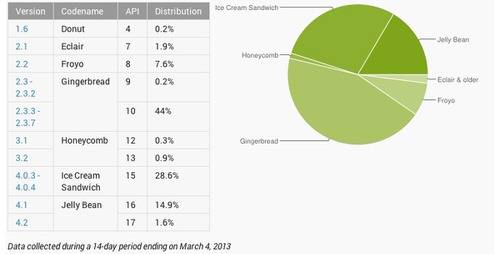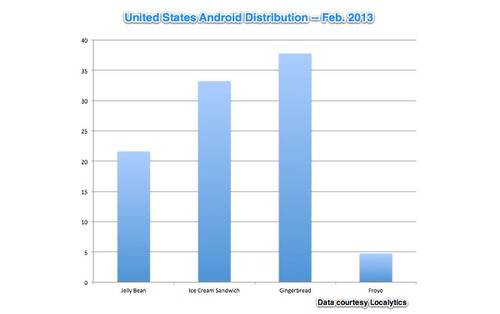
For the first time in a long time, Android 2.3 Gingerbread is no longer running on the majority of Android smartphones. According to Google’s dashboards, the two-year-old flavor of its Android mobile OS now runs on only 44.2% of devices.
It’s been a long, slow death for Gingerbread, which was released in December 2010. At the time, it offered a great leap in usability over Android’s two previous builds — Éclair and Froyo — and was the first version of Android to really take off with users worldwide.
But with the subsequent release of Ice Cream Sandwich (Dec. 2011) and two iterations of Jelly Bean (the first of which was in July 2012), most Gingerbread devices are either holdovers from people that have not yet upgraded to a new device, have had there firmware updated by their carriers and manufacturers or cheap devices that can be found in torrents in emerging markets.
Google names each version of Android alphabetically after tasty desserts. Android 2.2 was Frozen Yogurt, or Froyo; 2.3 was Gingerbread; 4.0 is Ice Cream Sandwich and 4.1-4.2 is Jelly Bean. (We’ll just overlook the ill-fated 3.0 release dubbed Honeycomb.) Google analyzes the usages of each version by tracking how many devices access the Google Play app store in a given month.
Another Way Android Is Like Windows
When ReadWrite managing editor Fred Paul wrote the other day that Android is like the mobile version of the Windows PC operating system, he was right in more ways than one. Fred mostly meant that Android is becoming a malware haven the way Windows once was. But the two OSes have a similar relationship when it comes to distribution.
For years, older versions of Windows have lingered in certain regions long after the rest of the world has moved on. That’s a somewhat bigger deal for Windows, since Microsoft puts out new versions roughly every three years — Android, by contrast, has had seven named versions since Sept. 2009. According to StatCounter’s global breakdown, Windows XP (2001 release, 6.6% global share) and Vista (2007 release, 24% share) are still running on roughly 30% of all Windows PCs. Even in the U.S., XP and Vista combined account for almost a full quarter of the entire Windows ecosystem.
Why do older versions of Windows stick around so long? In part, because Microsoft licenses a variety of manufacturers to make laptops and PCs and sell them across the world. Certain regions (Korea, for instance) or sets of buyers — such as federal, state and local governments — hang on to older versions longer to save money. Those same buyers also tend to favor cheaper PCs with older technology when it comes time to upgrade, and PC manufacturers cater to those customers.
With Android, The U.S. Is Ahead Of The Curve
The same phenomena occurs with Android, just on an accelerated scale. If you look at Android distribution in the U.S. against the rest of the world, you’ll see that the rate of adoption for newer versions is much higher here than across the Android base as a whole.
See the chart from Google on Android distribution from Feb. 2013 below. Gingerbread 2.3.x still makes up 44.2% of the entire ecosystem. Froyo makes up 7.6% and Éclair 1.9%. Overall, that means that the global distribution of Android is still majority running some version of 2.x at 53.7%.
Newer versions of Android have been gaining steam recently but are still in the minority. Android 4.0.x Ice Cream Sandwich reaches 28.6% of all Android devices while the newest Jelly Bean builds are on 16.5%.

In the U.S., the trend is reversed. According to numbers obtained by mobile analytics company Localytics, Ice Cream Sandwich builds were on 33% of Android devices in the country as of the end of Feb. 2013. Jelly Bean in the U.S also outperforms the global base of Android as a whole, at 21.62%. Together, the newest versions of Android make up 54.48% of Android devices in the U.S.

Gingerbread still accounts for the largest single slice at 38% in the U.S., but its share is starting to evaporate as manufacturers upgrade certain older devices and releasing new, popular devices — such as the Samsung Galaxy Note II, the Galaxy S3, the HTC One, the Motorola Razr HD series and so on — running the latest versions of Android.
Weeding Out Gingerbread In The Rest Of The World
When it comes to mobile distribution, the U.S. is the leading indicator of new smartphone adoption, at least when it comes to Android and Apple’s iPhone. Gingerbread devices in the U.S. are increasingly hard to find at carriers like AT&T and Verizon, and are often very cheap or free when they turn up.
In the rest of the world, Gingerbread’s long tail is still very prevalent, with companies like Huawei and ZTE serving mid-to-low-end Gingerbread phones to emerging markets like China, Indonesia and India.
The next wave of Android devices to hit the U.S. will just extend this trend. The HTC One runs Android Jelly Bean 4.1.2 while the upcoming Samsung Galaxy S4 is expected to run Jelly Bean 4.2.2. Huge marketing campaigns for both devices will probably push up share of the newest Android builds to 65% or higher by mid-year.
But just like older Windows versions have been harder to dig out of in the rest of the world, Android 2.3 will remain a large presence on a global scale in the foreseeable future.









